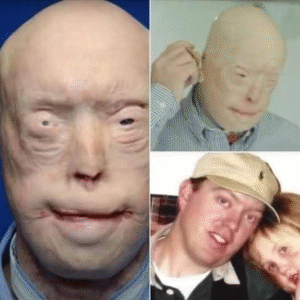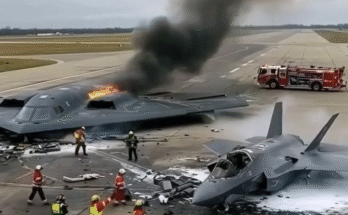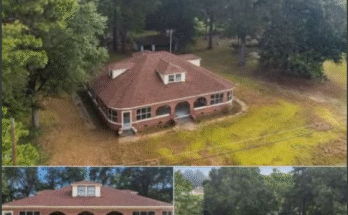The Tragedy That Changed Everything
On August 27, 2001, Hardison was responding to a routine house fire in his community. The scene quickly turned dangerous. While helping evacuate residents, he was trapped in the intense flames, and the fire engulfed him in seconds. The injuries he sustained were catastrophic: burns covering 95% of his body, including the total destruction of his face.
For the firefighter, who had dedicated his life to saving others, the irony was cruel. Hardison survived, but the aftermath was devastating. Simple acts like eating, breathing, and speaking became monumental challenges. The physical scars were matched by emotional trauma—the world he knew reflected back at him in a way that was unrecognizable.
For years, Hardison relied on reconstructive surgeries that offered partial solutions. Traditional techniques provided incremental improvement, but his face remained severely disfigured. He faced not only daily pain and medical complications but also social isolation, as the world often responded with discomfort or fear at his appearance.
A Search for Hope
Hardison’s struggle drew attention within both the medical community and the public. His story became a symbol of the risks firefighters take and the indomitable spirit required to endure such tragedies. Over the years, he underwent more than 70 reconstructive surgeries, including grafts from other parts of his body. These procedures helped restore functionality but could not fully rebuild the intricate structure of his face.
Doctors were searching for a solution that could go beyond what conventional surgery could accomplish. For Hardison, every day was a reminder of the limitations of human healing—and a chance to keep hope alive.
The Breakthrough: A Face Transplant
In 2015, Hardison became the recipient of one of the most complex medical procedures ever attempted: a full face transplant. This operation, performed at the NYU Langone Medical Center in New York, was a groundbreaking milestone in the field of reconstructive surgery.
The transplant was led by Dr. Eduardo D. Rodriguez, a pioneer in facial transplantation. The surgical team faced immense challenges. Unlike traditional transplants, which involve a single organ, a face transplant requires the delicate connection of skin, muscles, nerves, blood vessels, and bone structure. Success depends not only on surgical skill but also on the patient’s ability to adapt and heal, including rigorous rehabilitation.
The donor was a young woman who had died tragically, providing the tissues that would eventually allow Hardison to regain a semblance of normalcy. Hardison’s surgery lasted 26 hours, involving a multidisciplinary team of surgeons, anesthesiologists, and specialists. The procedure required meticulous planning, with every nerve and vessel mapped in advance to maximize function and appearance.
Recovery: A Journey of Patience and Determination
The surgery was only the beginning. Hardison faced months of intensive rehabilitation. Physical therapy, speech therapy, and facial exercises were essential to regain movement, sensation, and expression. For someone who had lived with disfigurement for over a decade, the process was as emotionally taxing as it was physically demanding.
But Hardison’s determination never wavered. Slowly, he regained the ability to eat normally, speak clearly, and express emotions through facial movements—functions that many of us take for granted. Each small milestone was a reminder of how far he had come and how transformative the procedure could be.
Medical Significance
Hardison’s face transplant was a landmark achievement in reconstructive surgery. It demonstrated that full facial transplantation is not only possible but can dramatically improve a patient’s quality of life. Surgeons learned valuable lessons about tissue compatibility, nerve regeneration, and postoperative care, knowledge that has since informed countless other procedures worldwide.
The operation also highlighted the importance of donor tissue and the ethical considerations surrounding transplantation. Every face transplant involves a profound emotional component—the donor’s family entrusting the memory of their loved one to someone in need, and the recipient adjusting to a new identity while honoring that gift.
The Human Spirit Beyond Medicine
While the surgery was a technical triumph, Hardison’s story resonates most because of the human spirit it embodies. He had faced a lifetime of adversity and remained determined to live fully despite his injuries. His courage inspired not only those in the medical field but also the public at large.
Hardison has since become an advocate for organ donation and reconstructive surgery. By sharing his journey, he helps others understand the possibilities of modern medicine while emphasizing resilience, hope, and gratitude. He continues to live actively, engaging with the community, giving talks, and demonstrating that life after trauma can still be meaningful and impactful.
A Life Transformed
Today, Patrick Hardison’s story stands as a testament to the intersection of human courage and medical innovation. From the firefighter who risked everything to save others, to the patient who endured years of pain and uncertainty, to the surgical team that pushed the boundaries of medicine, Hardison’s journey is a powerful reminder of what is possible when dedication meets opportunity.
The face transplant not only restored his appearance and basic functions but also symbolically restored his connection to the world. He can smile, eat, and speak in ways that once seemed impossible. More importantly, he can engage with life fully, no longer defined solely by tragedy.
Legacy and Inspiration
Patrick Hardison’s life is an inspiration on multiple levels. It is a story of heroism in the face of danger, perseverance through unimaginable hardship, and scientific progress that gives hope to countless individuals. His experience has influenced the field of reconstructive surgery, encouraged organ donation, and reminded society of the power of resilience and human compassion.
In interviews, Hardison often reflects not only on the miracle of his surgery but also on the gift of perspective. Life, he says, is unpredictable, and even in moments of devastation, there is room for hope, healing, and transformation. His journey from firefighter tragedy to medical marvel reminds us that the human body and spirit are capable of extraordinary feats when met with expertise, care, and determination.
Conclusion
Patrick Hardison’s story transcends the individual. It is a narrative about courage, perseverance, and the potential of modern medicine to change lives in ways once thought impossible. From the flames that once destroyed his life to the surgical miracle that restored it, Hardison embodies resilience and the enduring human will to overcome adversity. His journey serves as a beacon of hope for those facing overwhelming challenges and as a testament to the profound achievements that are possible when science and humanity intersect.


